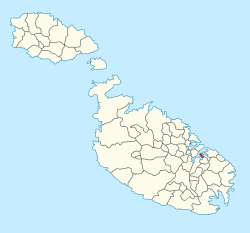Senglea
|
Senglea L-Isla Città Invicta, Civitas Invicta |
|||
|---|---|---|---|
| City and Local council | |||

From top: Skyline, typical street, Parish Church, Gardjola, Land Front
|
|||
|
|||
| Motto: Civitas Invicta (Belt Qatt Mirbuħa) (Unconquered City) |
|||
 |
|||
| Coordinates: 35°53′16″N 14°31′1″E / 35.88778°N 14.51694°ECoordinates: 35°53′16″N 14°31′1″E / 35.88778°N 14.51694°E | |||
| Country |
|
||
| Region | South Eastern Region | ||
| District | Southern Harbour District | ||
| Borders | Cospicua | ||
| Government | |||
| • Mayor | Joseph Casha (PL) | ||
| Area | |||
| • Total | 0.2 km2 (0.08 sq mi) | ||
| Population (March 2014) | |||
| • Total | 2,784 | ||
| • Density | 14,000/km2 (36,000/sq mi) | ||
| Demonym(s) | Senglean (m), Sengleana (f), Sengleani (pl) Isolan (m), Isolana (f), Isolani (pl) |
||
| Time zone | CET (UTC+1) | ||
| • Summer (DST) | CEST (UTC+2) | ||
| Postal code | ISL | ||
| Dialing code | 356 | ||
| ISO 3166 code | MT-20 | ||
| Patron saint |
Marija Bambina Christ the Redeemer |
||
| Day of festa |
8 September Third Sunday of June |
||
| Website | Official website | ||
Senglea (Maltese: L-Isla [ˈlɪslɐ]), also known by its title Città Invicta (or Civitas Invicta), is a fortified city in the South Eastern Region of Malta. It is one of the Three Cities in the Grand Harbour area, the other two being Cospicua and Vittoriosa, and has a population of slightly below three thousand people. The city's title Città Invicta was given because it managed to resist the Ottoman invasion at the Great Siege of Malta in 1565. The name is Senglea since the grandmaster who built it, Claude de la Sengle, gave this city a part of his name.
The island on which Senglea lies was joined by a land bridge to Cospicua during the time of the Knights of St. John and as a result, it became peninsular in shape. During the time of the Knights of St. John, Senglea was also used as a hunting area, and was known as L'Isola di San Giuliano.
In 1311 St. Julian's church or chapel was founded in Isola. This was the first building to be constructed on what later became Senglea. On 8 May 1552 the foundation stone of Fort St.Michael was laid. Work on the fort, which was designed by Architect Pedro Pardo, was completed in 1553. Construction of walled town Senglea took place during the following decade. The area, which had until the 1550s been known as Isola di San Giuliano or Isola di San Michele, was given city status by Grand Master Claude De La Sengle and was named after him.
Senglea played an important role in the Siege of Malta in 1565 and remained unconquered. The city was given the title Civitas Invicta (meaning "Unconquered City") by Grand Master Jean Parisot de Valette. In 1581 Senglea became a Parish dedicated to the Nativity of Our Lady. The donation of the statue of Our Lady, popularly known as "Il-Bambina", is estimated to have occurred in 1618. Many inhabitants of the city were killed in an outbreak of plague which affected Malta in 1676.
...
Wikipedia


